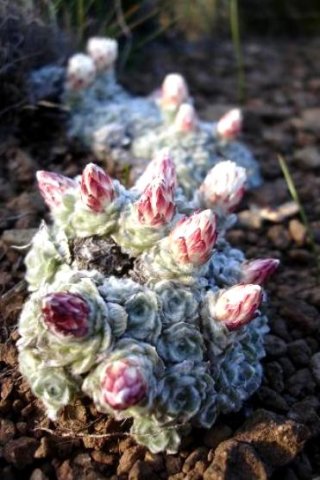Helichrysum milfordiae

Author: Ivan Lätti
Photographer: Judd Kirkel Welwitch
Helichrysum milfordiae, commonly known as the alpine everlasting or the spotted strawflower, is a matforming, dwarf perennial that reaches about 7 cm in height but spreads on the ground via stolons to around 30 cm in diameter. Numerous compact leaf rosettes are added on the evergreen plant over its lifetime. Old stems become woody and gnarled, young ones are soft and slender.
The elliptic, oval or obovate rosette leaves are blue grey to grey, densely covered in silvery to whitish hairs. Their soft, short blades sometimes end in pointed tips. The stem leaves below the open flowerheads are lance-shaped. They appear later when the blooms mature.
The flowerheads grow solitary from stem-tips, the leaf rosette centres. As in the photo, there are no stems present during the overly colourful bud stage. The short, leafy stems appear only later, once the heads are open. The involucres are less colourful by then, apart from the yellow disc floret centres revealed as the bracts spread.
The species distribution in South Africa is small, only the Drakensberg of southwest KwaZulu-Natal and some Lesotho Malutis.
The habitat is montane grassland, rocky or replete with rock sheets at high altitudes. The habitat population is deemed of least concern early in the twenty first century (Manning, 2009; iNaturalist; www.keys.lucidcentral.org; http://redlist.sanbi.org).

